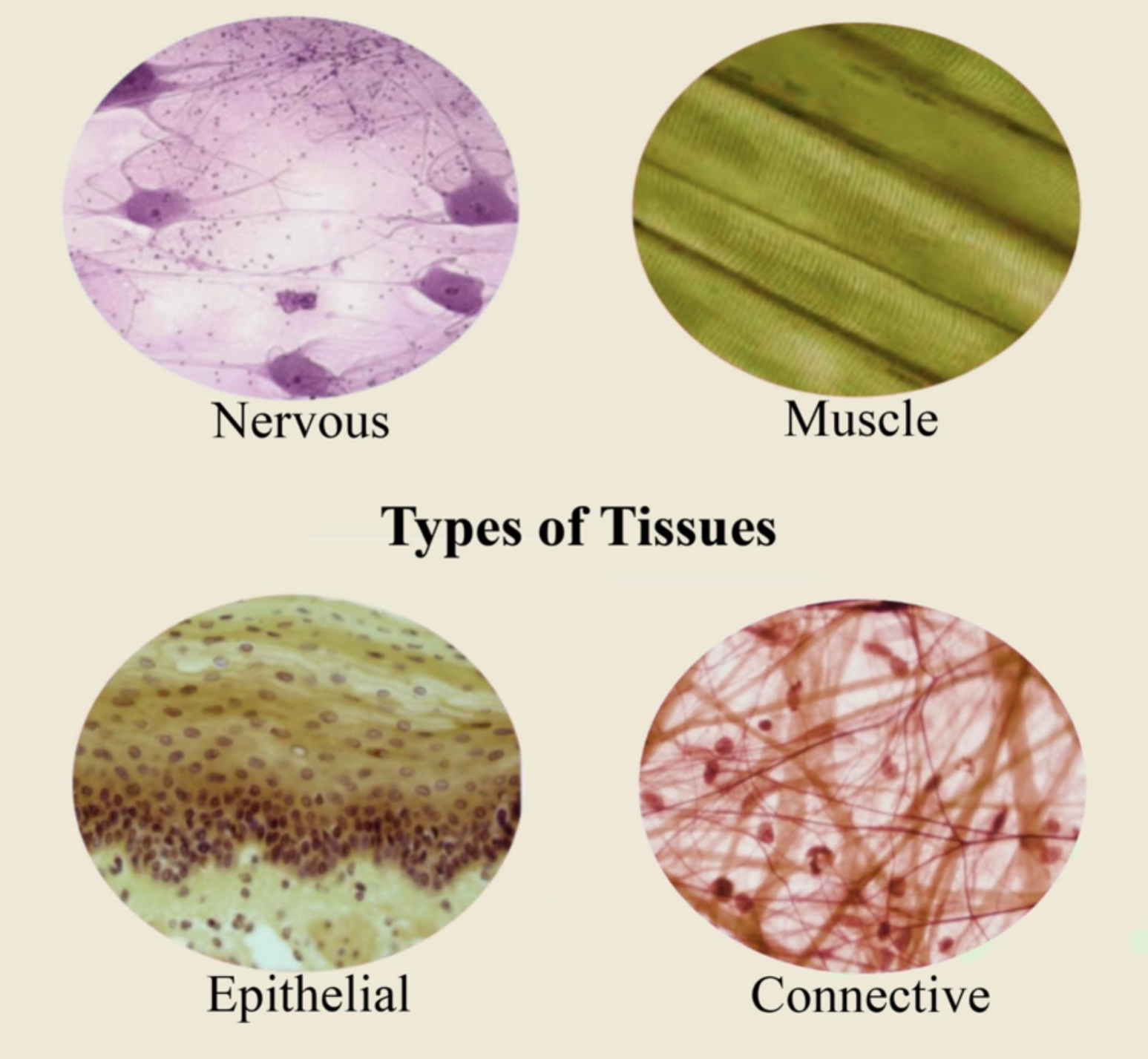What are the 4 Types of Tissues?
Tissues are groups of cells with a similar structure and function, forming an essential part of the human body. They create an intermediate level of organisation between cells and organs, allowing the body to function efficiently. Organs are composed of different tissues working together to perform specific tasks.
The study of tissues is called histology, while the study of tissue-related diseases is known as histopathology. Scientists analyse tissues using advanced tools like paraffin embedding and sectioning to understand their structure and function.
Types of Tissues in the Human Body

Tissues in the body are categorised into four primary types:
Epithelial Tissue
Connective Tissue
Muscle Tissue
Nervous Tissue
Each type has distinct roles essential for survival and bodily functions. Let’s explore them in detail.
1. Epithelial Tissue
Epithelial tissue forms the outer layers of organs and lines internal body surfaces, including the skin, airways, digestive tract, and reproductive system.
Functions of Epithelial Tissue:
Protects internal structures from pathogens, toxins, and physical damage.
Facilitates absorption, filtration, and secretion of substances.
Plays a key role in sensory reception and hormone secretion.
Assists in movement through diffusion and filtration processes.
Types of Epithelial Tissue:
Simple Epithelium: One cell layer thick, found in areas where absorption and filtration occur (e.g., lungs, intestines).
Stratified Epithelium: Multiple layers, offering protection (e.g., skin, oesophagus).
Glandular Epithelium: Involved in secretion (e.g., sweat glands, pancreas).
2. Connective Tissue
Connective tissues support and bind other tissues and organs together. They are composed of cells embedded in an extracellular matrix that provides strength and elasticity.
Types of Connective Tissue:
Fluid Connective Tissue: Blood and lymph are responsible for transport and immune responses.
Fibrous Connective Tissue: Tendons and ligaments, providing flexibility and support.
Skeletal Connective Tissue: Bone and cartilage, offering structural integrity.
Functions of Connective Tissue:
Provides shape, support, and strength to organs.
Stores energy and insulates the body.
Facilitates immune defence through phagocytic cells.
Transports essential substances like nutrients, gases, and hormones.
3. Muscle Tissue
Muscle tissue enables movement and force generation, whether for locomotion or internal organ function.
Types of Muscle Tissue:
Skeletal Muscle: Voluntary muscles attached to bones, involved in movement.
Cardiac Muscle: Found in the heart, responsible for pumping blood.
Smooth Muscle: Involuntary muscles in internal organs like the intestines and blood vessels.
Functions of Muscle Tissue:
Helps in voluntary actions like walking and lifting objects.
Maintains posture and body position.
Pumps blood through the circulatory system.
Controls breathing and regulates blood flow.
4. Nervous Tissue
Nervous tissue forms the brain, spinal cord, and peripheral nerves, enabling communication throughout the body.
Functions of Nervous Tissue:
Processes and transmits information via nerve signals.
Responds to stimuli and regulates body functions.
Plays a crucial role in memory, emotions, and reasoning.
Controls metabolic activities and maintains homeostasis.
Types of Plant Tissues
Plants also have specialised tissues essential for their growth and function. Plant tissues are classified based on their role in the plant’s structure and development.
1. Meristematic Tissue
This tissue consists of actively dividing cells responsible for plant growth.
Types of Meristematic Tissue:
Apical Meristem: Increases the height of plants.
Lateral Meristem: Helps in widening the plant stem.
Intercalary Meristem: Facilitates regrowth in grasses and other plants.
Functions of Meristematic Tissue:
Promotes primary and secondary plant growth.
Forms new organs and tissues.
Aids in the movement of water and nutrients.
2. Permanent Tissue
These tissues develop from meristematic cells but do not divide further.
Types of Permanent Tissue:
Simple Permanent Tissue: Includes parenchyma (storage), collenchyma (support), and sclerenchyma (rigidity).
Complex Permanent Tissue: Includes xylem (water transport) and phloem (nutrient transport).
Specialised Tissues: Glandular and secretory tissues involved in resin and latex production.
Functions of Permanent Tissue:
Stores food and nutrients.
Provides structural strength and support.
Facilitates transportation of water and food.
Protects the plant from external damage.
Unique Facts About Tissues
The human body contains over 200 different cell types, forming various tissues.
The smallest muscle tissue in the body is found in the middle ear.
Plants can regenerate tissues, a feature absent in most animals.
Blood, a fluid tissue, makes up 7-8% of human body weight.
Conclusion
Tissues are fundamental to both plants and animals, ensuring proper function, growth, and survival. Understanding tissues in the body, including epithelial tissue, connective tissue, muscle tissue, and nervous tissue, helps us appreciate how the body operates. This knowledge is essential for fields like medicine, histology, and botany.


FAQs on Tissues of the Human Body - Types, Functions and Importance
1. What are the 4 types of tissue?
The four types of tissue in the human body are epithelial tissue, connective tissue, muscle tissue, and nervous tissue.
2. What is the definition of human tissue?
Human tissue is a group of similar cells that work together to perform a specific function in the body.
3. Why is it called a tissue?
The term "tissue" originates from the Latin word "texere," meaning "to weave," indicating how cells are woven together to function collectively.
4. What are the body tissues?
Body tissues include epithelial, connective, muscle, and nervous tissues, each with unique functions essential for survival.
For more engaging biology concepts, explore Vedantu’s free resources and expert guidance!










